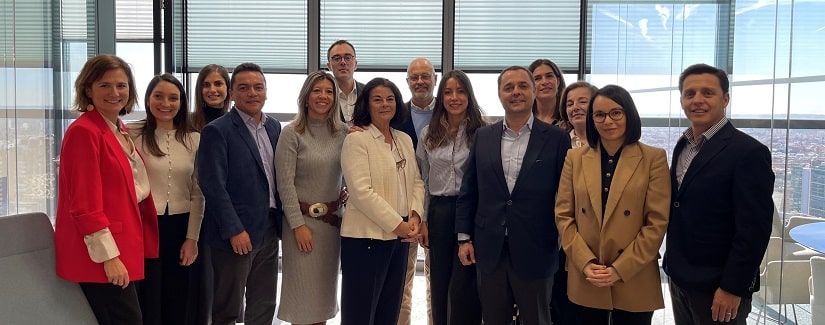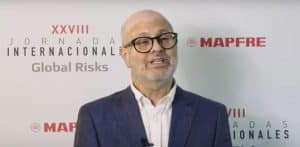Cristina Leon Vera | 12/03/2024
We took advantage of the visit from Luis Fernando Longo, Corporate Director of Risks and Insurance at Carvajal, to MAPFRE Global Risks to ask about the adaptations and challenges imposed by the management of the Major Risks by the company which is present in multiple Latin American countries.
You’re celebrating… 120 years of transforming lives, it’s the recurring theme of your anniversary. How have the risks changed from the founding of the company to the present and how has the company been adapting?
Since Carvajal was born in 1904, risks have been associated with all business activities. The key has been in the focus of the strategy with all its stakeholders, such as: Customers, Suppliers, Company Collaborators and Communities where the companies of the Carvajal Organization have a presence, understanding the situational context and anticipating the trends and challenges that the future brings, in order to be sustainable and resilient over time.
In addition to great activity, you also work in more than eight countries in Latin America. As Director of the Carvajal Captive, could you tell us about the technical control in each of the countries in an entity of such magnitudes?
The Carvajal Organization, by way of its risk policy, has integrated all aspects related to the identification, evaluation, treatment and monitoring of risks, based on international standards. With regard to Loss Control, activities are carried out under the same standard, based on Property Conservation Guidelines and measuring their magnitudes with the Risk Management tools for each region, taking into account their impacts and critical variables. These tools are useful for decision-making.
As relates to your current position, what are the benefits of having a Captive Company?
Some of the benefits we have found in the captive company that is over 20 years old have been:
- First, as an important theme to highlight, Silver is a Captive Company founded in 1995, which means that it is 28 years old, nearly 29 years old now, making it the first of Latin American origin in Bermuda.
- • The Captive Company generates greater efficiency in optimizing costs in insurance programs, providing availability of investment resources in protection schemes.
- • A greater participation in risk retention generates a position of confidence in our risks when participating in its insurance process, against the insurance and reinsurer sector, within an environment full of challenges and uncertainties.
Due to the development and evolution of your activity, what challenges/tests do you offer to the Insurance Industry? (new risks/coverages…)
The speed with which disruptive changes are occurring in the industries and the way the Carvajal Organization evolves, especially in the services sector, requires greater speed in the insurance industry seeking agility, efficiency and focus on the expectations of the insured party, which still represent great challenges in terms of coverage. For example, to adopt controls according to the magnitude of the risks, which are still generalized without taking into account the context and type of risk. We also face changes in the activity of some of our industries, such as Carvajal Packaging, which generates transformational challenges in which we need the support of the Insurance Industry.
How is Carvajal protected from instability in some countries where it has a presence?
As mentioned above, risk assessments and treatment are carried out and defined according to the nature of each of these, the accident prevention mechanisms, which will range from taking out insurance to avoiding the risk completely, if applicable.
At Carvajal, you are going through a process of transitioning to sustainable and innovative activity. Such is the case that you are turning to bagasse production of sugar cane. What has this change meant at the profitability level of the business and how do you think this step influences customer perception?
Carvajal Pulp y Paper, since its inception, has used the bagasse of sugar cane as a base raw material, taking advantage of the proximity of the two Propal plants to the sugar mills that have a presence in the area where the two plants are located. Work is done from each of its lines with all its stakeholders, educating and highlighting the benefits in terms of environmental sustainability, to offer its customers environmentally friendly products. This has been positive because more and more customers are more informed about what is consumed and the long-term benefit of our products. The challenge has been to be more efficient in faster processes, in order to achieve a better profitability of the products generated with this raw material.
In relation to the prevention of the risks faced by a company like Carvajal, what role does having a good engineering service and improvement program play?
Within the framework of Risk Management, the benefit that has been evidenced has been in the control of protections in all operations, which contributes to the culture of the Carvajal Organization in topics such as: taking care of the facilities, processes and our Human Capital in order to have safer facilities through industrial and human safety, and prevent situations that can affect the environment in the areas where our industrial operations are located.
Could you recall any claims that have been less impacted than they could have been, thanks to effective risk management?
There have really been no claims in recent times that have been a result of poor risk management. On the contrary, we can confirm that large losses have been avoided thanks to the effective accident prevention process, such as the case that occurred at Grupo Convermex’s operation in Monterrey, where the fire protection system acted before a fire spread during non-working hours.
Within the risk management policies defined by the Carvajal Organization is the record of cases that have been presented as “Lessons Learned,” which has helped us define turning points in the development of new projects. These experiences were taken as starting points in the analyses that are done from the moment a draft is developed.
Carvajal was the First MAPFRE Global Risks International Program (2009). What do you make of this relationship?
We value the development of the Carvajal Organization’s insurance program, optimizing the placement of our risks and making our retention scheme more effective. In this way, today, better leverage of coverage is achieved thanks to greater participation in the insurance context as a loss mitigating factor.
In closing, could you give us some final details regarding the future of the Company and its expansion plans?
As a context, the Carvajal Organization, in line with the challenges that lie ahead in the development of the areas of influence in which we develop our different social objectives in our different companies, has drawn up plans for expansion at different latitudes, especially in North America. The aim is to cover the US market, given the situation in supply chains, which are being weakened by the development that has been taking place in Asia. This poses the challenge of becoming increasingly efficient in order to achieve greater competitiveness, taking advantage of the close proximity of the markets in this area of influence.






